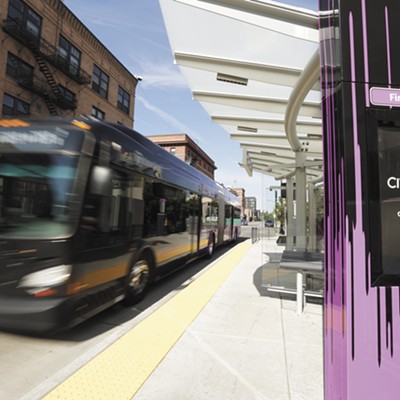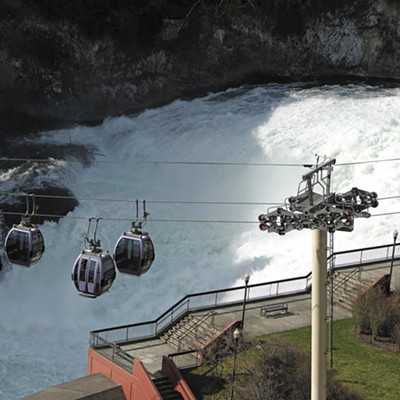During just a 10-year period of time, 70 textile mills were closed or relocated. They all came from a region where 80 percent of the entire United States cotton textile industry had existed — a percentage that shrunk to 20 percent in about 20 years.
So these corporations must have moved to Mexico, right? That damn NAFTA! Nope. These companies didn't move to Mexico; they moved to the American South from New England, leaving a trail of ghost mill towns in their wake.
During the early 1950s we lived in Newport, Rhode Island. I remember weekend family drives up through Fall River, Massachusetts, where we saw rows of late 19th-century brick industrial buildings — all boarded up.
And it didn't end with textiles. New England eventually lost jobs to the South in machinery, hosiery, apparel, electrical, paper, chemical and other important industries.
So why all this relocation? Long ago, in 1954 to be exact, John F. Kennedy, then a first-term senator from Massachusetts writing for the Atlantic Monthly, analyzed the causes. Kennedy acknowledged that the South had certain advantages: a milder climate, a larger potential workforce and cheaper power. He made clear that he wasn't complaining about industrialization in the South. Indeed, he praised the South for finally "obtaining some of New England's many and well known advantages in skilled labor, research markets and credit facilities." No, his complaint went to what he viewed to be an uneven playing field in large part created by Congress. He referred to the union-busting Taft-Hartley Act, together with the absence of federal minimum wage standards. All the more annoying was the South's unwillingness to acknowledge the important role that the federal government had played in the region's economic progress and social services.
Kennedy noted that at the same time the South denounced big government, it was more than willing to use cheap power, courtesy of the federally developed Tennessee Valley Authority. In contrast, New England, Kennedy wrote, hadn't "acquired for itself a single federal hydroelectric project."
Back to the resultant unfair labor practices, Kennedy noted that not one of the Northeast's mills that had moved still permitted collective bargaining. (This carried obvious long-term consequences, as today the U.S. ranks No. 1 in the world for its unequal distribution of wealth.)
Kennedy also drew attention to federal tax amortization benefits that Congress had granted to promote expansion in the South. He noted the unfair shipping rates and tax-free plant construction — all built with federal tax-exempt bonds.
Despite the troubles caused by these laws, Kennedy actually argued for more federal intervention, particularly where relocation was hit hardest. He wanted to see "loans and assistance to small business, retraining unemployed industrial workers [and] tax amortization benefits for industries expanding in areas of chronic unemployment." The federal government was best positioned to fund and direct all these initiatives. (Think of the WPA, PWA and the CCC; think also of the G.I. Bill, Medicare and Medicaid. And yes, more recently, the Affordable Care Act.)
Kennedy argued that his plan would benefit not just New England but the South as well. After all, as he pointed out, despite its recent economic development, the South continued to experience a range of problems that brought with them seriously threatening long-range implications, including inadequate use of water resources, one-industry towns, the debilitating effects of long-term unemployment and economically insecure old age — "all trouble," he pointed out, "to some degree in certain areas in the South, as well as in New England." (He might also have brought up and discussed the self-inflicted effects of racism in the South, but he didn't.)
Kennedy went on to note that even in 1954, employment in the South had "been affected by the impact of synthetic fibers, foreign competition and migration of the cotton textile industry" to Mexico, Central America and Asia. He argued that we ignore these storm signals at our peril; in effect, we tolerate robbing Peter to pay Paul — not a good way to go, especially in the global economy that Kennedy saw coming.
The comparisons to today are especially on point when you read how Kennedy labeled industries attracted by unfair labor practices as "migrants." He then asked a question as pertinent today as it was back in 1954: "What happens when [the South's] new found benefactor leaves for another bargain elsewhere?" Today, those bargain destinations are Mexico, China or Vietnam; in Kennedy's time it was South Carolina or Georgia.
And if you were an out-of-work textile worker in New England back in 1954, what difference would it have made whether your industry had relocated to South Carolina or Mexico? None whatsoever.
Kennedy concluded his article with these words of wisdom: Our goal should be, he wrote, "the expansion and prosperity of every section of the nation, not the ephemeral aggrandizement of one at the expense of another through the exploitation of impermanent and ultimately self-destroying values."
John F. Kennedy saw all of this coming — 40 years before NAFTA. ♦























